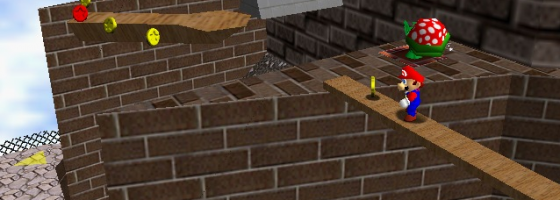Trending
Opinion: How will Project 2025 impact game developers?
The Heritage Foundation's manifesto for the possible next administration could do great harm to many, including large portions of the game development community.
Creating an effective control scheme is an important skill, and today's post looks at five key tips that can help you regardless of genre or design.

Building the control scheme for your video game is a thankless task. If you do it right, no one will notice it; fail, and you'll have a lot of angry consumers. Despite that, a great control scheme can make or break a game, and I want to talk about five important points that go into it.

super mario 64 (wikipedia)
The first thing you need to understand is simply the neutral position: A person's resting hand position on a gamepad or keyboard while playing. For keyboard and mouse games this can vary, but gamepads usually have one or two positions. The neutral position dictates where the player's fingers are exactly going to be when holding the controller. The reason why you need to understand this is because the neutral position is a guide for where you'll place your actions.
But before we get to placing the actions, you need to figure out just what they are first.
The next point is simple, but very important: Figuring out your verbs. The verbs of your game are any and all actions that the player will be doing. In a platformer, this can be as simple as, "run and jump," but a first person shooter is a different story.
For this section, we're also including any menu interactions as well. Once you've settled on your actions, the next step is breaking things down into primary and secondary actions.
The ultimate challenge of figuring out your control scheme is the fact that humans only have 10 fingers, and you probably have more actions than that. Primary and secondary actions are a way to frame differentiate your actions and make it easier to decide button placement.
Primary actions are those that define your game and will be in use constantly. Secondary actions are important to your game, but are more situational. Primary actions are typically assigned their own button within the neutral position. The player should be able to immediately use a primary action at a moment's notice.

Dark Souls 3
A good control scheme becomes second nature as quickly as possibleWhen it comes to secondary actions, their placement is not as strict. You should still be mindful of where the primary actions are, and place secondary actions reasonably close. A common beginner's mistake for PC game designers is to place secondary actions as far away on the keyboard as possible.
If someone has to actively think about where the button is for a command, then it's too far away on the input device.
The next point begins to take us into advance thinking on control scheme design. From the last point, you should have begun assigning primary and secondary actions to your input device. To take things a step further, you need to think about a person's hands.
Good UI design should break up primary actions between the two hands. If the left hand controls movement, then the right hand should jump. The reason is the more actions tied to one hand, the harder it will be to perform at once. Due to primary actions being used constantly, you don't want the player to have to stop doing one to do another.
Forcing the player to shift into different hand positions in order to play your game is not a sign of an effective control scheme. You can also use the left and right hands as a way to categorize the actions. For example: The left hand performs all maneuver actions while the right does all combat. Lastly, you should never put camera controls and movement on the same hand, as that just leads to confusion.
For our final section, I want to talk a little about shortcuts and ways to streamline your control scheme. Context sensitive commands can share the same button if the two commands are completely separate from one another.
You can also use the position of keys as a form of secondary association of commands. In Dark Souls, having the left and right triggers assigned to their respective slots was simple but effective.

control scheme
Splitting your commands between hands can make it easier to processWhen it comes to PC Games, I find it easier to use button positioning first before word association when placing buttons.
Many older PC games used H for health, O for open, D for drink and etc; leading to a control scheme all over the place.
In Starcraft 2, Blizzard used the positioning of the commands on the UI for hotkey placement which was easier to remember.
Creating a good control scheme is crucial for game development. While you can use control mapping alternative, it's still important to understand the best way of playing your game.
Be sure to play test your title to see how people are handling your game, and use that to make adjustments accordingly. At the end of the day, a great control scheme is one that is completely out of the player's mind. The less they're thinking about what they're holding in their hands, the better.
Hopefully these tips will help you out, and if you can think of anything else, let me know in the commands below.
Read more about:
BlogsYou May Also Like